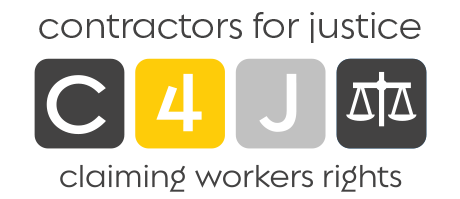Loan Charge Mitigation
We at C4J Ltd have worked tirelessly to find a resolution for Contractors or Workers affected by the Loan Charge Legislation.
During this time we have seen numerous challenges in the Courts with cases such as Hoey (First Tier Tribunal and Appeal to Upper Tier Tribunal) and Finucane (Court of Session), and while we don’t profess to have found a way to defeat the Loan Charge, we have identified in conjunction with both Leading Tax and Employment QC’s another angle to mitigate the tax liabilities being imposed by HMRC.
In short, we can reclaim the tax suffered by contractors/workers from the Agencies or Clients they worked through. In addition, we can also claim Holiday Entitlement that contractors/workers should have received but did not.
So how does this all work?
The contractor or worker is chargeable to Income Tax and Class 1 NICs on sums earned under the Income Tax (Earnings and Pensions) Act 2003 (“ITEPA”) on the basis that:
- The sums constitute “earnings” from employment under the general provisions in ss 10 and 62 ITEPA; and
- The sums earned are to be treated as “earnings” from employment under the provisions relating to persons providing services through an agency in s 44 ITEPA (and corresponding provisions relating to NICs) (“the agency rules”).
The Agencies are to be regarded as the employer for the purposes of the PAYE rules;
(a) accordingly, under those rules, those parties were liable to (but did not)
(i) deduct the income tax and Class 1 NICs due in respect of the earnings from sums paid by them under the arrangements or account to HMRC for such income tax,
We would add that HMRC was entitled to but did not take action to enforce such obligations against those parties, and they are as culpable as the Agency.
It is both our and Counsel’s view that as a consequence of the above:
- Accordingly, the contractor or worker is entitled to claim for any loss suffered as a result of the loan charge due to the negligence of the Agency in their failure to operate PAYE under the Agency Rules.
- The contractor or worker is entitled to claim from the Agency for any loss suffered due to the Intermediary placing you into a tax avoidance structure. Under the Law of Principal & Agent, where the Principal (The Agency) is liable for the actions of their Agent (The Intermediary) and if you suffered loss as a result of the Intermediary’s actions, then the Principal is responsible in Law for that loss you suffered.
Under normal circumstances, the Law of Tort allows a claim to be brought within three years of someone finding out they have a claim and allows a claimant to go back six years from that date. However, under certain circumstances, this can be extended to 15 years where it can be shown and proven the person was “Wilfully Neglect or Negligent.”
We believe we can plead Wilful Neglect as the judge defined this in R. v IRC ex p. Chisholm (1981) STC 253, who stated “Wilful” means ‘deliberate’ or ‘intentional.’ The persistent failure to deduct tax must therefore have been ‘wilful’, which is also supported by the advice received from QC.
So how much is this going to cost?
C4J operates on a “no win no fee” basis also known as a conditional fee arrangement that allows you to make a compensation claim without financial risk. You only ever pay anything if your claim is successful.

